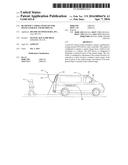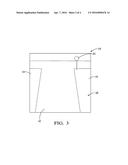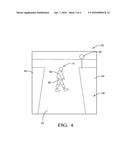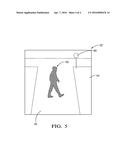Patent application title: REARVIEW CAMERA WITH GPS FOR IMAGE STORAGE AND RETRIEVAL
Inventors:
Manuel Ray Fairchild (Kokomo, IN, US)
IPC8 Class: AB60R100FI
USPC Class:
348148
Class name: Special applications observation of or from a specific location (e.g., surveillance) vehicular
Publication date: 2016-04-07
Patent application number: 20160096476
Abstract:
A rearview camera system includes a camera, a global positioning system
(GPS) device, and a controller. The camera is configured to capture a
current image from a field-of-view proximate to a vehicle. The GPS device
is configured to determine a current location of the current image. The
controller is configured to determine if the current location corresponds
to a prior location, compare a prior image of the prior location to the
current image, and indicate if an unexpected object is present in the
current image.Claims:
1. A rearview camera system for detecting an unexpected object behind a
vehicle, said system comprising: a camera configured to capture a current
image from a field-of-view proximate to a vehicle; a
global-position-system (GPS) device configured to determine a current
location of the current image; a controller configured to determine if
the current location corresponds to a prior location, compare a prior
image of the prior location to the current image, and indicate if an
unexpected object is present in the current image.
2. The system in accordance with claim 1, wherein the system includes a warning indicator, and the controller is further configured to activate the warning indicator if the unexpected object is present in the current image.
3. The system in accordance with claim 1, wherein the system includes a display configured to show the current image, and emphasize the unexpected object shown in the current image.
4. The system in accordance with claim 1, wherein the system is configured to ignore a known object in an excluded area of the prior image.
5. The system in accordance with claim 4, wherein the system is configured so an operator can designate the excluded area of the prior image.
Description:
TECHNICAL FIELD OF INVENTION
[0001] This disclosure generally relates to rearview camera system, and more particularly relates to the system using a global-position-system (GPS) device to determine if a current image of a location is different from a prior image of the same location, and indicate if an unexpected object is present in the current image.
BACKGROUND OF INVENTION
[0002] It is known to equip a vehicle with a back-up or rearview camera so an operator can more readily observe if an unexpected object is behind the vehicle. However, poor operator eyesight and hurried driving habits can lead to operator failure to detect an unexpected object.
SUMMARY OF THE INVENTION
[0003] In accordance with one embodiment, a rearview camera system for detecting an unexpected object behind a vehicle is provided. The system includes a camera, a global positioning system (GPS) device, and a controller. The camera is configured to capture a current image from a field-of-view proximate to a vehicle. The GPS device is configured to determine a current location of the current image. The controller is configured to determine if the current location corresponds to a prior location, compare a prior image of the prior location to the current image, and indicate if an unexpected object is present in the current image.
[0004] Further features and advantages will appear more clearly on a reading of the following detailed description of the preferred embodiment, which is given by way of non-limiting example only and with reference to the accompanying drawings.
BRIEF DESCRIPTION OF DRAWINGS
[0005] The present invention will now be described, by way of example with reference to the accompanying drawings, in which:
[0006] FIG. 1 is a side view of vehicle equipped with a system configured to detect an unexpected object proximate to the vehicle in accordance with one embodiment;
[0007] FIG. 2 is a diagram of the system of FIG. 1 in accordance with one embodiment;
[0008] FIG. 3 is an example scene of the area behind the vehicle of FIG. 1 in accordance with one embodiment;
[0009] FIG. 4 is an example scene of the area behind the vehicle of FIG. 1 in accordance with one embodiment; and
[0010] FIG. 5 is an example of an image displayed by the system of FIG. 1 in accordance with one embodiment.
DETAILED DESCRIPTION
[0011] FIG. 1 illustrates a non-limiting example of a rearview camera system, hereafter referred to as the system 10, suitable for use on a vehicle 12 for detecting an object, particularly an unexpected object 14, behind a vehicle 12. As will be explained in more detail below, the system 10 is generally configured to provide an operator 20 of a vehicle 12 a notification that an unexpected object 14 is proximate to the vehicle 12. In this example, the unexpected object 14 is a child walking behind the vehicle 12. The system 10 is also useful to detect an adult, an animal, other vehicle, or any obstruction with which the vehicle 12 may collide. The system 10 includes a camera 16 configured to capture a current image 40 (FIG. 4) from a field-of-view 22 proximate to (e.g. behind) the vehicle 12. In general, the camera 16 is mounted on the vehicle 12 so the field-of-view 22 useful to detect objects that may not be readily seen by the operator 20. In this non-limiting example, the field-of-view 22 is directed behind the vehicle 12. However, it is contemplated that the system 10 could be configured to detect an object beside or in front of the vehicle 12.
[0012] FIG. 2 further illustrates a non-limiting example of the system 10. The camera 16 is generally configured to output image data 26 indicative of visible light color (e.g. hue and saturation) and visible light intensity detected by pixels (not shown) in the camera 16. A suitable resolution for the camera may be provide by a pixel array characterized as 640 by 480 for a total of 307,200 pixels. Cameras of higher and lower resolution are commercially available from a wide variety of sources. The camera needs to have sufficient resolution so when the image data 26 is displayed to the operator 20, there is sufficient detail for the operator 20 to discern what is being displayed.
[0013] The system 10 also includes a global-position-system device, hereafter the GPS device 18, configured to determine a current location 56 of the current image 40. The current location 56 may be characterized by, but is not limited to, GPS coordinates and/or an orientation of the vehicle 12 (i.e. the direction the vehicle is facing), as will be recognized by those in the art. A suitable GPS device is readily available from a wide variety of commercial sources.
[0014] Continuing to refer to FIGS. 1 and 2, the system 10 may include a controller 30 configured to receive image data 26 from the camera 16, and GPS data 28 from the GPS device 18. The controller 30 may include a processor (not shown) such as a microprocessor or other control circuitry as should be evident to those in the art. The controller 30 may include memory (not shown), including non-volatile memory, such as electrically erasable programmable read-only memory (EEPROM) for storing one or more images from the camera 16, locations from the GPS device 18, routines, thresholds and the like. The one or more routines may be executed by the processor to perform steps for processing signals received by the controller 30 for combining or fusing the image data 26 and the GPS data 28 as described herein.
[0015] The GPS device 18 is utilized by the controller 30 to determine if the current location 56 (FIG. 4) corresponds to a prior location 58 (FIG. 3). If the current location 56 and the prior location 58 correspond, i.e. are essentially the same, it is expected that the prior image 54 and the current image 40 will essentially match. If the locations correspond, the controller 30 compares a prior image 54 of the prior location 58 that was previously stored in the controller 30 to the current image 40 being received from the camera 16. If the images do not match, i.e. there is an unexpected object 14 in the current image 40, the system 10 is configured to indicate that the unexpected object 14 is present in the current image 40, and may convey this indication in a number of ways, as will be explained in more detail later. Video image subtraction/comparison software is commercially available that would be suitable for comparing the prior image 54 to the current image 40 to determine if the unexpected object 14 is present in the field-of-view 22.
[0016] The system 10 may also include a display 32 configured to display an image to the operator 20 that corresponds to a display signal 34 output by the controller 30. Devices suitable for the display 32 are commercially available. The display 32 may be located anywhere in the vehicle 12 where the operator 20 can readily view the display 32; for example as part of an instrument display panel directly forward of the operator 20, or as part of a centralized instrumentation arrangement between the operator seat and passenger seat, or as part of a rear-view mirror assembly. The system 10 may also include a warning indicator 36 such as an indicator light, audible alarm, or vibrating device coupled to the steering wheel or the operator's seat. In general, the warning indicator 36 is configured to receive a warning signal 38 from the controller 30, and in response to the warning indicator 36 output a light, sound, haptic, or other action to attract the attention of the operator 20 when the unexpected object 14 is detected in the current image 40.
[0017] FIG. 3 is a non-limiting example of a prior image 54 from the camera 16 that was stored by the controller 30. The system 10 may be configured so the operator 20 can review the prior image 54 and designated part of the prior image 54 as an excluded area 44, and/or part of the prior image 54 as an area-of-interest 42. In this example, the area-of-interest 42 is a driveway behind the vehicle 20, and the excluded area 44 is a lawn adjacent to the driveway. The excluded area 44 may include an expected or known object 60, such as a mailbox. By designating part of the prior image 54, the controller 30 is able to more quickly align and compare the current image 40 to the prior image 54 to determine if an unexpected object 14 (FIG. 4) is present. In other words, the system 10 is configured to ignore the known object 60 in the excluded area 44 of the prior image 54.
[0018] The system 10 may be configured so the operator 20 can designate what part of the prior image 54 is the excluded area 44 of the prior image 54 by, for example, having the display 32 be a touch screen type display, and the system 10 be operable so the operator 20 can wipe a finger across the excluded area when shown on the display. Alternatively, the system 10 may automatically determine what part of the prior image 54 is the excluded area 44 based on an expected or previously detected travel path of the vehicle 12.
[0019] FIG. 5 shows a non-limiting example of a highlighted image 52 as the current image 40 could appear on the display 32 where the unexpected object is displayed as a highlighted object 50. The highlighted object 50 may be emphasized by overlaying a contrasting color (e.g. red), or by varying the intensity of the highlighted object in a step-wise manner (e.g. bright-dark-bright-etc.) in order to emphasize the unexpected object shown in the current image to be more readily detected by the operator 20.
[0020] Accordingly, a rearview camera system (the system 10), and a controller 30 for the system 10 is provided. By using the GPS data 28 to detect locations frequented by the vehicle 12 (e.g. the operator's garage or workplace parking space), prior images of those locations can be stored by the controller 30 and then later compared to the current image 40 from the camera 16 to more readily determine if an unexpected object 14 is proximate to or in the expected travel path of the vehicle 12.
[0021] While this invention has been described in terms of the preferred embodiments thereof, it is not intended to be so limited, but rather only to the extent set forth in the claims that follow.
User Contributions:
Comment about this patent or add new information about this topic:





